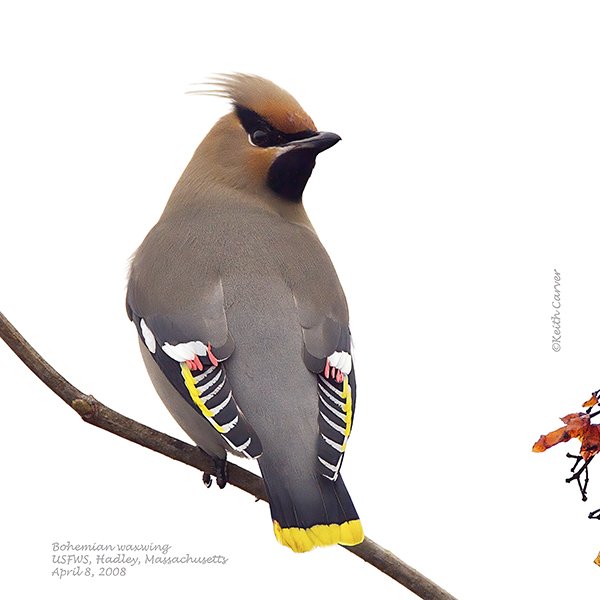Bird of the Month: Bohemian Waxwing
Written by Andy McCormick
Andy McCormick, Volunteer and Former Board President of Eastside Audubon
The Bohemian Waxwing is the wandering relative of the wider waxwing family and it winters in Washington.
The Bohemian Waxwing joins the Cedar Waxwing (B. cedorum) and Japanese Waxwing (B. japonica) in the genus Bombycilla, from the Latin, bombyx, meaning silk, in reference to the silky look of their feathers. However, the species epithet garrulus, Latin for talkative, is a bit of a misnomer, because like other waxwings, the Bohemian does not sing. It was named for the European Jay, which is resembles, and which is in the genus Garrulus (Holloway). A bohemian is a wanderer or vagabond and the name is appropriate as this bird will fly in flocks looking for fruiting trees on which to feed. All the waxwings are named for the wax-like red tips of their secondary flight feathers.
HIGH ARCTIC BREEDER
Possibly because it nests at a higher latitude than the Cedar Waxwing, the Bohemian does not begin nesting until early June. It appears to have evolved to time its nesting when insects and tree fruits will be most abundant. While foraging for insects they sally out from a perch to capture them in flight. However, large flocks of waxwings will forage communally in trees for berries and other fruits.
The Bohemian Waxwing is the only waxwing that has a world-wide population. It is a common bird around the world in the arctic taiga (boreal) forest where it breeds in conifers, most often in spruce trees. The male and female cooperate on building a cup nest of twigs, grasses, and moss lined with feathers, but only the female incubates the eggs, which are bluish-gray with black spots. The young hatch in about two weeks and fledge in another two weeks. The young may stay with the parents for several months (Kaufman).
Bohemian Waxwing
Scientific Name: Bombycilla garrulus
Length: 8.25”
Wingspan: 14.5”
Weight: 2oz (56g)
AOU Alpha Code: BOWA
WINTER WANDERINGS
Bohemian Waxwings have a reputation for an itinerant lifestyle because of their wide-ranging winter flocks in search of trees with sugary fruits such as cherries, apples, hawthorns, mountain ashes, and serviceberries. These flocks can number in the hundreds and sometimes thousands in central North America as they move southward in winter. Each year some of these birds visit Eastern Washington. It is when a Bohemian Waxwing joins a flock of Cedar Waxwings that one can wander to Western Washington. It is worth checking all the waxwings in a flock to look for a possible Bohemian. Photos of Bohemian Waxwings including some of large flocks can be found at the Macaulay Library.
The Bohemian can be differentiated from the Cedar Waxwing by its larger, plumper appearance, rufous face, gray belly, and large and obvious cinnamon colored undertail coverts. The red waxy tips of the secondaries are less obvious on the Bohemian. White tips on the primary flight feathers give the wing of the Bohemian a uniquely serrated appearance. Both species share the yellow tip on the tail.
CONSERVATION AND MANAGEMENT
We are fortunate that the population of Bohemian Waxwings is stable, and some recent winter counts are also showing an increase in numbers. This rise may be linked to the efficiency with which waxwings take advantage of plantings of fruiting shrubs and trees in home and park landscapes. However, some care with placement of plantings is important because of the risk for window strikes. Plantings along roadsides may also present a danger of strikes from passing vehicles while the birds are feeding (Witmer).
Also contributing to increase in waxwing populations was the banning of DDT in 1972. Removing this chemical from the environment proved beneficial for many bird species. The improvement may indicate that pesticides can be detrimental for waxwings who thrive on berries and fruits. (Witmer). The flocking behavior of Bohemian Waxwing provides some protection from predators, but also presents a risk of a threat that could expose many members of the flock. However, the Bohemian spends most of its year high in the boreal region and may be protected from many harms associated with human development.
Photo credit Keith Carver. References available upon request from amccormick@eastsideaudubon.org.



